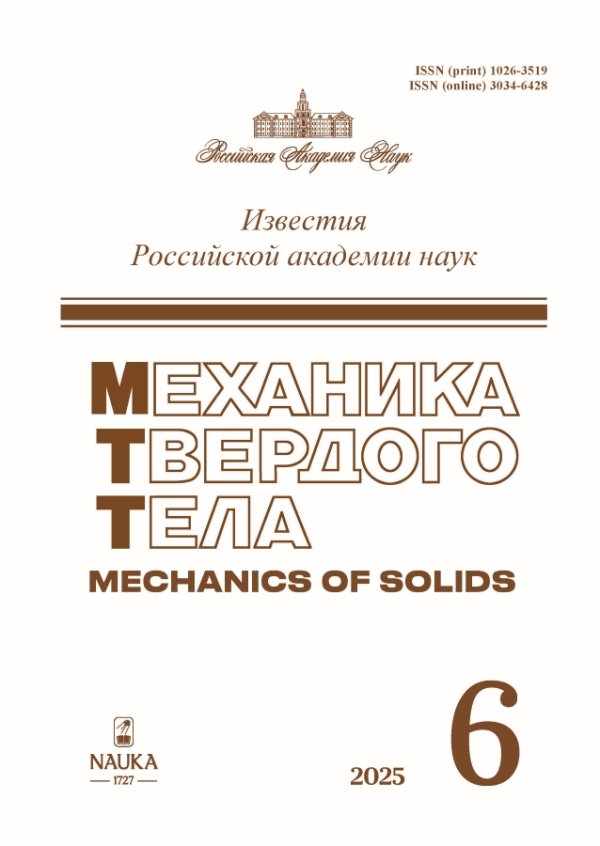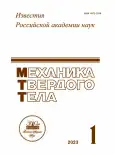Calculation of the Stress-Strain State of a Polymer Composite in a Direct Electric Current Field
- Authors: Lyukshin P.A.1, Lyukshin B.A.1,2,3, Panin S.V.1,3, Bochkareva S.A.1,2
-
Affiliations:
- Institute of Strength Physics and Materials Science, Siberian Branch, Russian Academy of Sciences
- Tomsk State University of Control Systems and Radioelectronics
- National Research Tomsk State University
- Issue: No 1 (2023)
- Pages: 142-155
- Section: Articles
- URL: https://journals.rcsi.science/1026-3519/article/view/137501
- DOI: https://doi.org/10.31857/S0572329922600232
- EDN: https://elibrary.ru/KLQDXU
- ID: 137501
Cite item
Full Text
Abstract
In electrically conductive composites placed in an electric field, heat is released and nonuniform temperature fields are formed. This circumstance, in turn, induces strains and stresses in such composites. The article solves a sequence of unrelated boundary value problems: electrical conductivity in a field of direct electric current, thermal conductivity, thermoelasticity. It is shown that when an electric current flows in copper-graphite and copper-filled polymer composites, displacements, deformations, and stresses occur even in the case when the components of the composite do not have a piezoelectric effect.
About the authors
P. A. Lyukshin
Institute of Strength Physics and Materials Science, Siberian Branch, Russian Academy of Sciences
Email: petrljuk@ispms.tsc.ru
Tomsk, 634055 Russia
B. A. Lyukshin
Institute of Strength Physics and Materials Science, Siberian Branch, Russian Academy of Sciences; Tomsk State University of Control Systems and Radioelectronics; National Research Tomsk State University
Email: lba2008@yandex.ru
Tomsk, 634055 Russia; Tomsk, 634050 Russia; Tomsk, 634050 Russia
S. V. Panin
Institute of Strength Physics and Materials Science, Siberian Branch, Russian Academy of Sciences; National Research Tomsk State University
Email: svp@ispms.tsc.ru
Tomsk, 634055 Russia; Tomsk, 634050 Russia
S. A. Bochkareva
Institute of Strength Physics and Materials Science, Siberian Branch, Russian Academy of Sciences; Tomsk State University of Control Systems and Radioelectronics
Author for correspondence.
Email: bochkarevas@ispms.ru
Tomsk, 634055 Russia; Tomsk, 634050 Russia
References
- Skelhorn D. Particulate fillers in elastomers. In: Rothon RN (ed) Particulate-filled polymer composites. 2nd ed. Shrewsbury, UK: Rapra Tec. Lim., 2003. 324 p.
- Hohenberger W. Fillers and reinforcements/coupling agents // Plastics Additives Handbook. 5th ed. Ed. by H. Zweifel, R. D. Maier, M. Schiller. Munich: Carl Fanser Verlag, 2001. P. 919–966.
- Masenelli-Varlot K., Chazeau L., Gauthier C., Bogner A., Cavaillé J.Y. The relationship between the electrical and mechanical properties of polymer–nanotube nanocomposites and their microstructure // Compos. Sci. Technol. 2009. V. 69. P. 1533–1539. https://doi.org/10.1016/j.compscitech.2009.01.035
- Hassan H.H., Nasr G.M. and El-Waily M.A. Electrical and mechanical properties of aluminum-loaded NBR composites // J. Elastomers Plastics. 2013. V. 45. P. 121–141. https://doi.org/10.1177/0095244312462160
- Grazioli D., Zadin V., Brandell D., Simone A. Electrochemical-mechanical modeling of solid polymer electrolytes: Stress development and non-uniform electric current density in trench geometry microbatteries // Electrochimica Acta. 2019. V. 296. P. 1142–1162. https://doi.org/10.1016/j.electacta.2018.07.146
- Talin A.A., Ruzmetov D., Kolmakov A., McKelvey K., Ware N., Gabaly F. El, Dunn B., White H.S. Fabrication, testing, and simulation of all-solid-state three-dimensional Li-Ion batteries // ACS Appl. Mater. Interfaces. 2016. V. 8. P. 32385–32391. https://doi.org/10.1021/acsami.6b12244
- Wang X.-S., Tang H.-P., Li X.-D., Hua X. Investigations on the mechanical properties of conducting polymer coating-substrate structures and their influencing factors. Review // Int. J. Mol. Sci. 2009. V. 10. P. 5257–5284. https://doi.org/10.3390/ijms10125257
- Namsheer K., Rout C.S. Conducting polymers: a comprehensive review on recent advances in synthesis, properties and applications // RSC Adv. 2021. V. 11. P. 5659–5697. https://doi.org/10.1039/d0ra07800j
- Kim N., Lienemann S., Petsagkourakis I., Mengistie D.A., Kee S., Ederth T., Gueskine V., Leclère P., Lazzaroni R., Crispin X., Tybrandt K. Elastic conducting polymer composites in thermoelectric modules // Nat. Commun. 2020. V. 11 (1). № 1424. P. 1–10. https://doi.org/10.1038/s41467-020-15135-w
- Melling D., Jager E.W.H. Conducting polymers as EAPs: characterization methods and metrics // Electromechanically Active Polymers. Polymers and Polymeric. Composites: A Reference Series. Springer, 2016. P. 319–351. https://doi.org/10.1007/978-3-319-31530-0_14
- Mohd Radzuan N.A., Sulong A.B., Sahari J. A review of high-temperature proton exchange membrane fuel cell (HT-PEMFC) system // Int. J. Hydrogen Energy. 2017. V. 42 (14). № 6. P. 9262–9273. https://doi.org/10.1016/j.ijhydene.2016.03.045
- Plesse C., Vidal F., Randriamahazaka H., Teyssié D., Chevrot C. Synthesis and characterization of conducting interpenetrating polymer networks for new actuators // Polymer. 2005. V. 46. P. 7771–7778. https://doi.org/10.1016/j.polymer.2005.03.103
- Fu P., Liu H., Chu X. An efficient multiscale computational formulation for geometric nonlinear analysis of heterogeneous piezoelectric composite // Compos. Struct. 2017. 167. P. 191–206. https://doi.org/10.1016/j.compstruct.2017.02.005
- Yaghmaie R., Ghosh S. Computational modeling of finite deformation piezoelectric material behavior coupling transient electrical and mechanical fields // J. Computat. Phys. 2018. V. 373. P. 148–170. https://doi.org/10.1016/j.jcp.2018.06.070
- Koh S.J.A., Zhou T., Li J., Zhao X., Hong W., Zhu J., Suo Z. Mechanisms of large actuation strain in dielectric elastomers // J. Polym. Sci. Part B. Polym. Phys. 2011. V. 49. P. 504–515.
- Mota A., Zimmerman J.A. A variational, finite-deformation constitutive model for piezoelectric materials // Int. J. Numer. Methods Eng. 2011. V. 85 (6). P. 752–767.
- Атабеков Г.И., Купалян С.Д., Тимофеев А.Б. и др. Теоретические основы электротехники: Учебник для студентов втузов. В 3-х частях. М.: Энергия, 1979. Ч. 2, 3. 432 с.
- Нейман Л.Р., Демирчян К.С. Теоретические основы электротехники. Л.: Энергия, 1975. Т. 2. 407 с.
- Дульнев Г.Н., Заричняк Ю.П. Теплопроводность смесей и композиционных материалов. Справочная книга. Л.: Энергия, 1974. 246 с.
- Segerlind L. Applied Finite Element Analysis. N.Y.: John Willey & Sons, 1976. = Сегерлинд Л. Применение метода конечных элементов. М.: Мир, 1979. 392 с.
- Neto E.A.S., Peri’c D., Owen D.R.J. Computational methods for plasticity theory and applications. John Wiley & Sons Ltd., 2008. 816 p.
- Zienkiewicz O.C., Taylor R.L., Zhu J.Z. The Finite Element Method: Its Basis and Fundamentals, 7th Ed. Butterworth-Heinemann, 2013. 752 p.
- Гришаева Н.Ю., Люкшин П.А., Люкшин Б.А., Панин С.В., Бочкарева С.А., Реутов Ю.А., Матолыгина Н.Ю. Модификация теплофизических характеристик полимеров введением микронаполнителей // Мех. композиц. матер. констр. 2016. Т. 22. № 3. С. 342–361.
- Bochkareva S.A., Grishaeva N.Yu., Lyukshin B.A., Lyukshin P.A., Matolygina N.Yu., Panin S.V., Reutov Yu.A. A unified approach to determining the effective physicomechanical characteristics of filled polymer composites based on variational principles // Mech. Compos. Mater. 2019. V. 54. № 6. P. 775–788. https://doi.org/10.1007/s11029-019-9782-8
Supplementary files
















